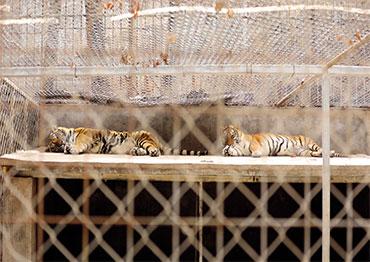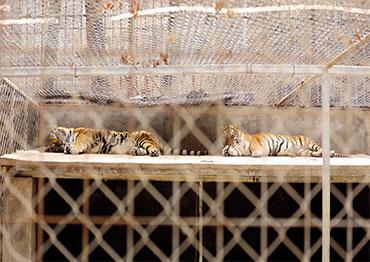Li built his base along the mountain slope, with tiger cages sitting along the contours. There is a constant echo of tigers roaring. Some big cats are housed in individual cages, some are in a male-female pair, but divided into separate cages. Except for an open feeding window, the cages are locked, though some parts of the tiger houses are connected to fenced areas on the mountain. When the weather is good, the tigers can roam outside.
The big cats, while not used to strangers, are habituated to people, and approach the front of the cages without hostility or aggression.
As the reporter walked closer to the cages, some tigers took their unfinished food, mainly still-frozen chicken and duck, and walked away. The tigers looked relatively well-kept, and did not appear to display the repetitive behaviors typical of captive animals.
“These tigers were raised in captivity since birth. Compared to wild tigers, they’re less aggressive and watchful,” said a keeper surnamed Tian. He said their largest male Siberian tiger weighs around 250 kilos.
They mostly eat frozen chicken, duck, beef, eggs and milk. “Our boss buys the food and sends it up,” Tian said, adding that a delivery might be thousands of kilos of meat. “Most young beasts eat frozen chicken and frozen duck, pregnant females eat some beef, and young and older tigers need milk, eggs and beef. They totally consume at least 350- 400 kilograms of meat a day, but it’s not enough. These animals need to eat a lot and the food is hard to afford.”
Tian’s wife complained the tigers often roar at night. “They don’t get enough to eat, so they don’t sleep well,” Tian said.
“Food costs up to 10,000 yuan (US$1,447) a day, so you can calculate how much money we need every month or every year. We can’t sell tickets for tourists, and we can’t sell the tigers to other zoos. So it’s basically investment without any return,” Tian said, then looked at a tiger in a cage and sighed.
The base employs four workers, including Tian and his wife.
Before he came to the base in February, Tian, 62, and his wife worked as animal keepers at Qinhuangdao Wildlife Park in Hebei Province for more than 20 years, with a monthly salary of 6,000 yuan (US$868). He used to be an elephant keeper, but he feels confident in his new role. “Animals all need the same things, to eat, drink, defecate and urinate, so as long as they’re not sick, they can survive.”
He admitted that compared with other animals, the biggest issue is giving the big cats medications when they get sick, especially injections. This means calling in veterinarians. “They’re really vigilant and they only eat meat. If you hide medicine inside the meat, they spit out the medicine and still swallow the meat,” Tian said.
Another keeper, surnamed Guo, showed NewsChina his torn clothes and scarred arms. “We get scratched often, and once it happened to me, I really understood how different tigers and lions are from cats and dogs. So we have a rule that no one can touch them, except our boss.”

 Old Version
Old Version

